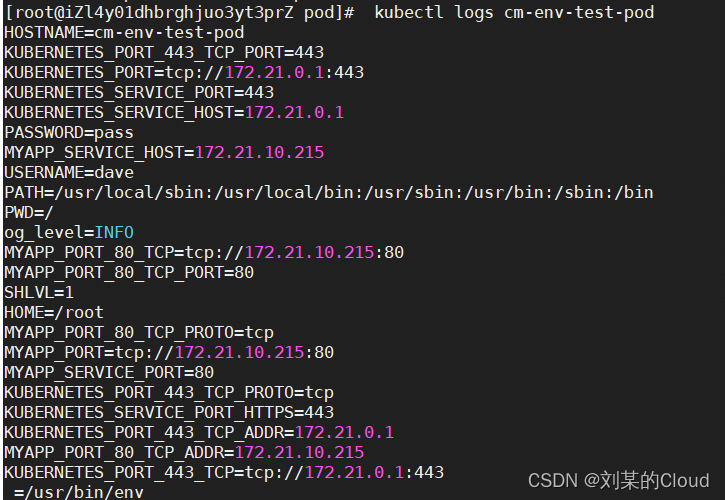目录
简介:
ConfigMap 功能在 Kubernetes1.2 版本中引入,许多应用程序会从配置文件、命令行参数或环境变量中读取配置信息。ConfigMap API 给我们提供了向容器中注入配置信息的机制,ConfigMap 可以被用来保存单个属性,也可以用来保存整个配置文件或者 JSON 二进制等对象。
一、ComfigMap的创建
1.使用目录创建
mkdir configmap
#创建configmap的目录,目录下创建文件,基于这个目录创建configmap
vim game.file
version=1.17
name=dave
age=18
vim ui.properties
level=2
color=yellow
kubectl create configmap game-config --from-file=../configmap/
#基于configmap目录创建名为game-config的configmap。
#--from-file指定在目录下的所有文件都会被用在 ConfigMap 里面创建一个键值对,键的名字就是文件名,值就是文件的内容2.使用文件创建
kubectl create configmap game-config-2 --from-file=./game.file
#基于文件创建
#--from-file这个参数可以使用多次,你可以使用两次分别指定上个实例中的那两个配置文件,效果就跟指定整个目录是一样的。kubectl get cm
#configmap的简称是cm
kubectl get cm game-config -o yaml
#以yaml格式查看名为game-config的cm
kubectl describe cm game-config
#查看cm的详细信息
3.使用命令行创建
kubectl create configmap literal-config --from-literal=name=dave --from-literal=password=pass
#创建的类型为configmap,configmap的名字为literal-config,名字为name,值是dave,名字为password,值为pass
kubectl get configmaps literal-config -o yaml
#查看创建的cm
二、Pod中使用ConfigMap
1.使用ConfigMap代替环境变量
vim configmap-literal.yaml
#创建configmap的yaml文件
apiVersion: v1
kind: ConfigMap
metadata:
name: literal-config
namespace: default
data:
name: dave
password: pass
kubectl apply -f configmap-literal.yaml
#基于yaml文件运行configmapvim configmap-env.yaml
#创建yaml文件
apiVersion: v1
kind: ConfigMap
metadata:
name: env-config
namespace: default
data:
og_level: INFO
kubectl apply -f configmap-env.yaml
#基于yaml文件运行configmapvim configmap-pod.yaml
#创建pod使用cm的yaml文件
apiVersion: v1
kind: Pod
metadata:
name: cm-env-test-pod
spec:
containers:
- name: test-container
image: centos:7.9.2009
command: [ "/bin/sh", "-c", "env" ]
env:
- name: USERNAME #创建一个环境变量的名字
valueFrom: #来源
configMapKeyRef: #来源于configMapKeyRef
name: literal-config #来自于上面创建的literal-config
key: name #来自于name字段
- name: PASSWORD
valueFrom:
configMapKeyRef:
name: literal-config
key: password
envFrom: #使用envFrom字段可以将env-config中的所有键值对作为环境变量导入到Pod中
- configMapRef:
name: env-config
restartPolicy: Never
kubectl create -f configmap-pod.yaml
#根据yaml文件创建pod
kubectl get pod
kubectl logs cm-env-test-pod
#查看pod的日志
2.使用ConfigMap设置命令行参数
vim cm-command-dapi-test-pod
apiVersion: v1
kind: Pod
metadata:
name: cm-command-dapi-test-pod
spec:
containers:
- name: test-container
image: centos:7.9.2009
command: [ "/bin/sh", "-c", "echo $(USERNAME) $(PASSWORD)" ]
env:
- name: USERNAME
valueFrom:
configMapKeyRef:
name: literal-config
key: name
- name: PASSWORD
valueFrom:
configMapKeyRef:
name: literal-config
key: password
restartPolicy: Never
kubectl create -f cm-command-dapi-test-pod
kubectl get pod
kubectl logs cm-command-dapi-test-pod
3.使用ConfigMap用做数据卷插件
vim cm-volume-test-pod
apiVersion: v1
kind: Pod
metadata:
name: cm-volume-test-pod
spec:
containers:
- name: test-container
image: centos:7.9.2009
command: [ "/bin/sh","-c","tailf /var/log/yum.log" ] #持久化运行,使容器保持运行,不会退出。
volumeMounts: #挂载volume卷
- name: config-volume
mountPath: /etc/config
volumes:
- name: config-volume #卷的名字叫config-volume
configMap: #基于configMap提供的
name: literal-config #基于名字为literal-config的configMap提供的
restartPolicy: Never
kubectl apply -f cm-volume-test-pod
kubectl get pod
kubectl exec -it cm-volume-test-pod -- /bin/bash
#进入pod内的容器,这里pod内只有一个容器,如果pod内有多个容器,需要-c指定容器名。
#进入容器后,执行下列命令,查看挂载的volume卷的信息。
#为什么这里这么设计,因为这里支持热更新
#什么叫热更新呢,就是我现在把configmap的对象改变的话,这里的内容也会变化,
#注意:这里不是共享,这是注入。
如果共享过多的话,会造成过多的资源损耗
注入的话就不会有这个问题,先注入10个pod,这10个pod注入以后,再注入下10pod
#什么叫注入,cat这个文件,重定向到你的目录下,这叫注入。
三、ConfigMap的热更新
vim hot-update.yaml
apiVersion: v1
kind: ConfigMap
metadata:
name: log-config
namespace: default
data:
log_level: INFO
---
apiVersion: extensions/v1beta1
kind: Deployment
metadata:
name: hot-update
spec:
replicas: 2
selector:
matchLabels:
run: nginx
template:
metadata:
labels:
run: nginx
spec:
containers:
- name: nginx
image: nginx:latest
imagePullPolicy: IfNotPresent
ports:
- containerPort: 80
volumeMounts:
- name: config-volume
mountPath: /etc/config
volumes:
- name: config-volume
configMap:
name: log-config
kubectl create -f hot-update.yaml
kubectl get cm
#查看刚刚创建的名为log-config的cm。
开第二个终端
while 2>1;do kubectl exec hot-update-5f9f99b44f-sm7kf -- cat /etc/config/log_level;sleep 1s;date;done
#观察信息
终端1:
kubectl edit cm log-config
#修改data里的键值INFO为log_level:ERROR
#annotations:里面的INFO为ERROR

终端2查看变化

kubectl get deployment hot-update -o yaml
#查看yaml文件
kubectl patch deployment hot-update --patch '{"spec": {"template": {"metadata": {"annotations": {"version/config": "20190411" }}}}}'
#更新版本
kubectl get deployment hot-update -o yaml
#再次查看yaml文件
kubectl get pod
#pod已更新

kubectl patch deployment hot-update --patch '{"spec": {"template": {"metadata": {"annotations": {"version/config": "20190412" }}}}}'
#修改版本号的会再一次触发更新




















 3342
3342











 被折叠的 条评论
为什么被折叠?
被折叠的 条评论
为什么被折叠?








